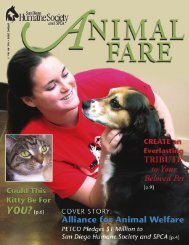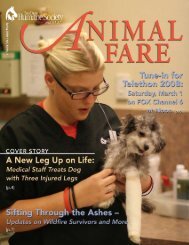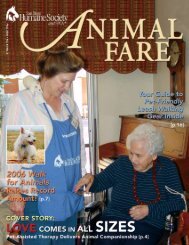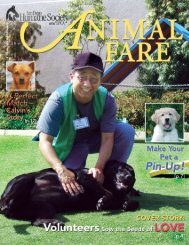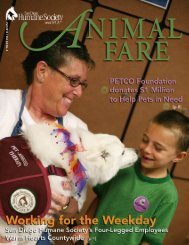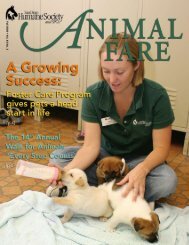Fall 2007 ⢠V ol. 42 No. 3 - San Diego Humane Society and SPCA
Fall 2007 ⢠V ol. 42 No. 3 - San Diego Humane Society and SPCA
Fall 2007 ⢠V ol. 42 No. 3 - San Diego Humane Society and SPCA
Create successful ePaper yourself
Turn your PDF publications into a flip-book with our unique Google optimized e-Paper software.
president’s message<br />
How Training Helps Our<br />
Adoptable Pets Find<br />
New Homes<br />
Mark G<strong>ol</strong>dstein, D.V.M.,<br />
CAWA, President of<br />
the <strong>San</strong> <strong>Diego</strong> <strong>Humane</strong><br />
<strong>Society</strong> <strong>and</strong> <strong>SPCA</strong><br />
with his dog Ren.<br />
In this issue you will read how the <strong>San</strong> <strong>Diego</strong> <strong>Humane</strong> <strong>Society</strong> <strong>and</strong> <strong>SPCA</strong>’s certified behavior training staff helps<br />
pet parents work on their pet’s behavior issues. In addition to their work with pet parents in our community,<br />
our behavior trainers also play an essential r<strong>ol</strong>e in how we prepare our shelter pets for adoption into their new<br />
homes. Thanks to generous support from our community, we are able to provide essential training to our shelter<br />
animals in order to make them more appealing to potential adopters, to assist in reducing their stress levels during<br />
their stay with us, <strong>and</strong> also to ensure a more successful transition to their new homes.<br />
Despite the fact that our available pets are housed in apartment-like settings <strong>and</strong> have daily interactions with<br />
staff <strong>and</strong> v<strong>ol</strong>unteers, a number of pets who come to the <strong>Humane</strong> <strong>Society</strong> can become stressed by the change in their<br />
environment <strong>and</strong>/or normal routine, as well as the proximity of other animals.<br />
To ease our pets’ stress levels, <strong>Humane</strong> <strong>Society</strong> behavior trainers work with pets on an individual basis, both inside<br />
<strong>and</strong> outside of their habitats, to make each pet’s stay in our adoption program more pleasant. For example, training<br />
a shy dog that his bed or crate is a stress-free place he can go when he is unsure can help calm him <strong>and</strong> alleviate his<br />
anxiety. Over time, the end result is a better-behaved pet who, in turn, will attract more potential adopters <strong>and</strong> has a<br />
higher potential to do well in his new home.<br />
In other cases, the simple observation of a pet’s reaction to his environment <strong>and</strong> taking steps to alleviate anything<br />
stress-causing can make a big difference in our animals’ well being. For instance, our trainers may recommend that a<br />
dog who reacts to potential adopters at his habitat window by barking (much like a dog at home might bark at<br />
someone at the door) have a shade placed over his window. This decreases the startle-factor of people suddenly<br />
popping in <strong>and</strong> out of sight, <strong>and</strong> helps him to relax. Such observations <strong>and</strong> recommendations by our trainers make it<br />
easier for our pets to find new homes <strong>and</strong> can aid in devising s<strong>ol</strong>utions to potential behavior problems before the pet<br />
has even gone to a new home.<br />
In addition to reducing our pets’ stress <strong>and</strong> anxiety, the h<strong>and</strong>s-on training methods our behavior <strong>and</strong> training<br />
team uses with our animals to modify <strong>and</strong> shape behavior is essential in preparing our pets for adoption. Using<br />
positive reinforcement training techniques which reward pets for their good behavior, our trainers work with pets to<br />
encourage behaviors that will make it easier for them to find homes. Whether it’s teaching a dog that the best way to<br />
get attention is by sitting quietly (<strong>and</strong> not jumping!) or by working with an under-socialized cat to enjoy touching<br />
<strong>and</strong> petting, our behavior trainers’ work increases the overall adoptability of our pets. In the long run, the time our<br />
trainers spend teaching <strong>and</strong> training our pets results in better companion animals as well as more successful<br />
adoptions <strong>and</strong> homes for our pets.<br />
It is only thanks to support from patrons like you that the <strong>San</strong> <strong>Diego</strong> <strong>Humane</strong> <strong>Society</strong> is able to take the sheltering<br />
<strong>and</strong> adoption of our pets to a new level with our team of certified behavior trainers. Thank you for continuing to<br />
support animals in need <strong>and</strong> for helping us to find them new, loving homes.<br />
In our next issue of AnimalFare I look forward to talking about Behavioral Assessments <strong>and</strong> how we use this<br />
observational to<strong>ol</strong> to find our animals the best home matches possible.<br />
Mark G<strong>ol</strong>dstein, D.V.M., CAWA<br />
President of the <strong>San</strong> <strong>Diego</strong> <strong>Humane</strong> <strong>Society</strong> <strong>and</strong> <strong>SPCA</strong><br />
2 www.sdhumane.org<br />
AnimalFare • <strong>Fall</strong> <strong>2007</strong><br />
Photo: Melisa Codgell



